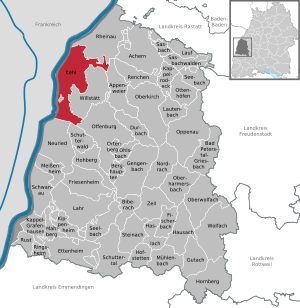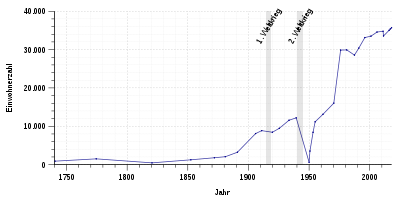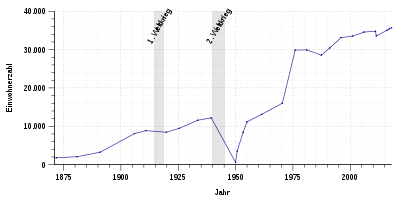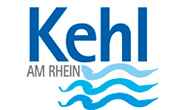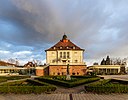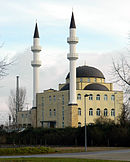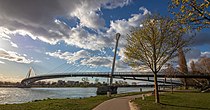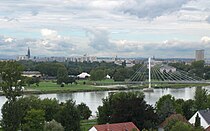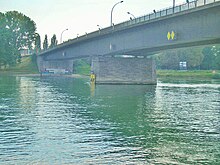Throat
| coat of arms | Germany map | |
|---|---|---|
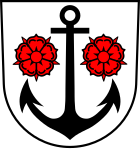
|
Coordinates: 48 ° 34 ' N , 7 ° 49' E |
|
| Basic data | ||
| State : | Baden-Württemberg | |
| Administrative region : | Freiburg | |
| County : | Ortenau district | |
| Height : | 139 m above sea level NHN | |
| Area : | 75.07 km 2 | |
| Residents: | 36,089 (Dec. 31, 2018) | |
| Population density : | 481 inhabitants per km 2 | |
| Postal code : | 77694 | |
| Primaries : | 07851, 07852, 07853, 07854 | |
| License plate : | OG, BH , KEL, LR, WOL | |
| Community key : | 08 3 17 057 | |
| City structure: | Core city and 10 districts | |
City administration address : |
Hauptstrasse 85 77694 Kehl |
|
| Website : | ||
| Lord Mayor : | Toni Vetrano ( CDU ) | |
| Location of the city of Kehl in the Ortenau district | ||
Kehl is a city in the west of Baden-Württemberg on the Rhine opposite Strasbourg , and about the same distance from Karlsruhe (75 kilometers) in the north and Freiburg im Breisgau (80 kilometers) in the south. After the district town of Offenburg and behind Lahr / Black Forest, it is the third largest town in the Ortenau district and forms a middle center in the area of the regional center Offenburg. Since January 1, 1971, Kehl has been a major district town . As a former bridgehead to the areas on the right bank of the Rhine in France, Kehl was often the scene of acts of war and was destroyed several times. However, the current structure of the city and a number of buildings are still shaped by the work of Friedrich Weinbrenner .
geography
Geographical location
The core town of Kehl is located in the Upper Rhine Plain , around three kilometers south of the confluence of the Kinzig in the Rhine. The city has always been important as a port city. It is located in the former floodplain of the Rhine, Kinzig and Schutter .
Neighboring communities
The following cities and municipalities border the city of Kehl ( clockwise , starting in the north):
Rheinau , Appenweier , Willstätt , Offenburg, Schutterwald and Neuried (all of the Ortenau district). In the west, the Rhine forms the border with France with the capital of Alsace , Strasbourg.
City structure
Core city
In 1910 the old town of Kehl and the village of Kehl, which formed a double municipality with Sundheim, were combined to form the new town of Kehl. Today the city center of Kehl is in the area of the old town . Due to its location on the northern edge of the city, the term inner city is not to be understood geographically, but functionally. The inner city is characterized by a dense, urban design and the convergence of the transport infrastructure (train station, tram). The pedestrian zone is also located in the city center. The former area of the village of Kehl extends in a south-westerly direction. This is characterized by a less dense development, partly still with the village character.
The Commission Island is located between the Rhine and an arm of the old Rhine that extends into the area of the core city , a residential area classified as high-quality, in which, among other things, courts, authorities or, for example, the Kehler hospital are located. Since the State Horticultural Show in 2004, the Passerelle des deux Rives has been located on the banks of the Rhine on Commission Island .
The urban area, which was created in 1910, has since grown to include several housing estates, first the Kronenhof settlement in a south-westerly direction and the Kreuzmatt residential area in a south-westerly direction, which is characterized by apartment buildings . The Kreuzmatt was built during the French occupation after the Second World War, among other things to build officers' apartments. Today the Kreuzmatt is more of a social hotspot in Kehl, where a large part of the city's social housing can be found.
In the course of further urban development, the Sölling settlement emerged in the east of the city center and the Niedereich, Wolfsgrube and Kronenhof residential quarters in the south. The Schneelären residential area on the southern outskirts has been developed since 2015.
Sundheim
Sundheim is no longer an independent municipality since the merger of Kehl Stadt and Kehl Dorf. Sundheim borders directly on the rest of the city of Kehl in a south-westerly direction and today has the character of a residential area, such as the adjacent Niedereich area. Sundheim does not have its own local council or mayor. Sundheim has become known beyond regional borders for the Sundheimer chicken .
Districts
The municipalities of Auenheim , Bodersweier , Goldscheuer (with Marlen and Kittersburg ), Hohnhurst , Kork , Leutesheim , Neumühl , Odelshofen , Querbach and Zierolshofen were incorporated as part of the territorial reform of the 1970s . All of these localities have their own local administration.
Some districts have additional, often spatially separate, residential areas or residential areas with their own name, which often have very few residents and whose boundaries are in some cases not precisely defined. These include Kittersburger Mühle, Rheinwärterhaus and Uhl residential building in Goldscheuer, Auenheimer Mühle, Korker Mühle and Ziegelei in Kork and Honau and Leutesheimer Mühle in Leutesheim.
Spatial planning
Kehl forms a middle center in the area of the regional center Offenburg in the southern Upper Rhine region . In addition to the city of Kehl, the city of Rheinau and the municipality of Willstätt also belong to the central area of Kehl . There are also links with the Strasbourg area in France .
Protected areas
In the city area there are three nature reserves ( Altwasser Goldscheuer (3.197), Roßwört (3.170) and Sundheimer Grund (3.228)), three landscape protection areas ( Altwasser Goldscheuer (3.17.023), Roßwört (3.17.019) and Sundheimer Grund (3.17.024)) , four FFH areas ( eastern Hanauer Land (7413341), Rhine lowlands from Wittenweier to Kehl (7513341), Untere Schutter and Unditz (7513341) and western Hanauer Land (7313341)) and six bird sanctuaries ( Gottswald (7513442), Kammbach lowland ( (7413441)), Kinzig-Schutter-Niederung (7513441), Korker Wald (7313442), Rhine Low Kehl - Helmlingen (7313401) and Rhine Low Nonnenweier - Kehl (7512401)). Status: October 2018
History of the city of Kehl
Founded until 1800
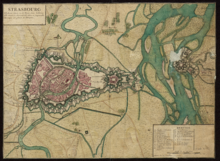
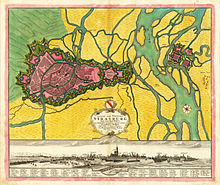
The oldest surviving mention of Kehl comes from 1038. In 1333 the construction of the first Rhine bridge, the Langen Bruck , between Kehl and Strasbourg was started and from 1388 there was a permanent road connection between the two places. Kehl has always been part of the defense of Strasbourg. In the 15th century there were three settlements, the actual Kehl (bridgehead), the village of Sundheim and the so-called "middle village". The descendants of residents of Iringheim (southwest of today's core city) and Hundsfeld (south of today's core city), which were abandoned due to flooding, lived here . The settlements were a condominium of the gentlemen von Geroldseck , von Böcklin , von Nassau , Grohstein and Bock. In 1497 half of the property went to the Margraves of Baden .
After Kehl was taken by France in 1678 under Louis XIV , construction of the new Kehl fortress began in 1683 by the military architect Sébastien Le Prestre de Vauban . This fortress became Baden again in 1698 and from 1771 belonged to the margraviate of Baden-Durlach . In the east of the Kehl Fortress, the residents of the old village of Kehl had founded a new village of Kehl, which was an independent municipality until 1910. In 1774, the municipality of Kehl, located within the fortress, was granted city rights by Margrave Karl Friedrich von Baden .
1800 to 1953
After several changes between France, Baden and Austria , the fortifications were dismantled in 1815 when they were returned to Baden ( Peace of Paris ). The town and village of Kehl (with Sundheim) then belonged to the Kehl district, whose seat was in Kork at that time. Between 1842 and 1847 the first port facility was built by the Baden State Railway Administration. The construction of the railway bridge over the Rhine in 1861 made it possible for the first time to travel directly by train from Paris to Vienna. The locomotive change required for this was carried out in Kehl.
During the Franco-Prussian War of 1870/71, the city was again the target of French attacks and destroyed.
In 1881 the seat of the Kehl office was moved from Kork to Kehl. In the late 19th century, a belt of fortifications consisting of 14 forts was built to defend Strasbourg against France . Three of the forts were located to the right of the Rhine: The “ Blumenthal ” fort near Kehl-Auenheim was destroyed in the First World War. The other two “Kehler Forts”, Fort “ Bose ” and Fort “ Kirchbach ” , were blown up after the Second World War . Between 1919 and 1930 Kehl was occupied by France.
In 1924, the Kehl district became part of the Kehl district , to which several communities were added in 1936 after the Oberkirch district was abolished. Kehl was in the so-called “ Red Zone ” on the Siegfried Line , which was evacuated when the war broke out: On the night of September 3rd to 4th, 1939 the population was evacuated to the Black Forest by special trains and was only allowed to return after the occupation of France by German troops . Kehl then became a suburb of Strasbourg. This status was retained even after the end of National Socialism . Kehl was released in accordance with the Washington Agreement on the evacuation of the city of Kehl by France from April 8, 1949 in 42 partial releases from July 29, 1949 to April 8, 1953. At that time (1945 to 1953) Sundheim was an independent municipality, which was then reunited with the city of Kehl. The city and the entire district of Kehl then belonged to the administrative district of South Baden within Baden-Württemberg.
1960 to 2000
In 1960 the Europe Bridge was opened over the Rhine to Strasbourg. The population of the city of Kehl exceeded the threshold of 20,000 in 1971 as part of the municipal reform . As a result, the city administration submitted the application for a major district town , which the state government of Baden-Württemberg approved with effect from January 1, 1972. In the district reform on 1 January 1973, the district Kehl, however, was resolved, his territory was primarily on the newly formed Ortenaukreis about (the since 2014, the old Kehler license plates KEL reused).
A pedestrian zone was built in several construction phases between autumn 1990 and 1994 . The first phase of construction stretched from the town hall to what was then the “Schneider department store”. The further expansion took place in later construction phases up to the Weinbrennerhaus. In 1994 the marketplace was closed to car traffic and has been the heart of the pedestrian zone ever since. Parallel was built in the northern city on the site of the old school (in operation until 1970, demolition of 1989), the building complex "Centrum on the market", which the newly created pedestrian area with space for retail, residential and office space, such as a parking garage round should. Today the pedestrian zone extends over parts of the northern main street and parts of the market and flower street. A section of Kasernenstrasse was redesigned in the course of the "City Center Kehl", which was built in 2007, with a similar traffic-calmed effect and represents an expansion in its function.
Along the federal highway 28 leading through Kehl , which was only known as a thoroughfare to France, banking , retail , petrol stations and the fast food sector in particular acquired wasteland from former industrial and freight forwarding companies in the 1990s .
2000 until today
In the 2000s, Kehl's development took on unusual proportions for a city of its size. Urban development links between Strasbourg and Kehl did not exist or hardly existed until the 1990s due to the post-war and border period. Large-scale projects of all kinds have been implemented especially along the B 28. The main road should no longer serve as a border to the adjacent industrial port, but rather be understood as a boulevard . In 2004, this urban development boost was particularly evident in Kehl. A private investor acquired the real estate of the Kehler train station from the Deutsche Bahn and renovated the property for use for offices, businesses and hotels. At the same time, the city of Kehl carried out major renovation work on the station forecourt (with the creation of the so-called Ortenauplatz) and a large part of the B 28 up to the Europabrücke. In the same year, a multi-storey building was acquired opposite the train station and converted into a three-star hotel. At the end of 2007 the groundbreaking ceremony was held for a 10,000 m² shopping center (City Center Kehl) on the northern edge of the city center, which was also built along the B 28 and opened in April 2009. Opposite this shopping center, another car dealership was built in 2010 on one of the last fallow areas along the B28.
Since October 7, 2005, Kehl has been part of the Strasbourg-Ortenau Eurodistrict .
Another project was the crossing of the Rhine by the Strasbourg tram. In 2008 the cities of Strasbourg and Kehl commissioned a feasibility study. At the end of 2009, a contract for a draft plan was signed. The planned extension of tram line D should reduce road traffic (35,000 vehicles / day) and regular bus traffic (220,000 passengers / year) between the cities. To this end, between 2014 and 2016, the Beatus Rhenanus Bridge, a fourth Rhine bridge near Kehl was built. The tram line to Kehler Bahnhof opened on April 29, 2017.
The upgrading of the urban area of Port du Rhin in the direction of Kehl was also started in Strasbourg. In 2012, both cities started a Europe-wide urban development competition aimed at promoting the development of the unused customs areas in both cities. The areas are opposite one another on the Rhine and are to be developed uniformly across borders. In the course of this, the city of Kehl is also planning the development of the “Kasernenplatz” and “Yachthafen” areas in the medium and long term.
Since 2015, in the southern part of Kehls, between the housing estates Wolfsgrube and Kronenhof, the housing estate "Snow Laires" has been built on 6.4 hectares of open space. This should provide living space for around 800 people, primarily (around 60%) in the form of apartment buildings . The landmark of Kehl, the water tower , is included by a quarter square.
History of the districts of Kehl
The districts of Kehl also have a long history:
Auenheim was first mentioned in 888 as Ouuanheim and Hohnhurst in 1295. The places belonged to the office of Willstätt of the Lichtenberg rule , later the County of Hanau-Lichtenberg and came to Baden in 1803 . After that they were parishes in the district of Kork or Kehl.
Bodersweier was first mentioned in 884 as Bothalaswileri, Leutesheim in 1233 as Lutensheim and Zierolshofen in 1295. All three places later belonged to the County of Hanau-Lichtenberg and were part of the Rheinbischofsheim court in the Lichtenau district. In 1803 the places came to Baden and were assigned to the Rheinbischofsheim office. When it was dissolved in 1857, they came to the office of Kork or Kehl. From the Nazi dictatorship were Jews of the district persecuted and killed 17 of them. Since 1984 a memorial stone in the cemetery commemorates these victims of the Shoah .
Goldscheuer was first mentioned in 1425 as Goldschure. It was an extension of Marlen, to which it always belonged. Marlen was first mentioned in 1282 as Marheim. The associated place Kittersburg was first mentioned in 1283 as Kuterschburg. All three places belonged to changing rulers throughout history. Parts belonged to the County of Hanau-Lichtenberg and the County of Ortenau. In 1803 the places came to Baden and formed the municipality of Marlen in the Offenburg Oberamt . In 1936 the name of the community was changed to Goldscheuer and this was assigned to the district office or district of Kehl .
Cork was first mentioned in 778 as a "villa" in a letter of gift to the Eschau monastery. Cork was the main town and seat of the mayor's office of a forest cooperative for other communities in the surrounding area. It was a fiefdom of the Lords of Fürstenberg, later it belonged to the County of Hanau-Lichtenberg and was the seat of the court in the Willstätt district, whose seat was moved to Kork at the beginning of the 18th century. Even after the transition to Baden, Kork remained the seat of the office until it was moved to Kehl in 1881.
Neumühl was first mentioned in 1271 as apud novum molendinum, Odelshofen in 1310 as Otolzhofen and Querbach in 1372. Neumühl and Odelshofen were cork development settlements and therefore shared the fortunes of Kork. They belonged to the cork court in the Willstätt office of the Lichtenberg lordship. Querbach, on the other hand, originally belonged to the Lichtenau office of the Lichtenberg rule. Half of the Lichtenberg rule was transferred to the County of Hanau-Lichtenberg in 1480 and the other half in 1570 and was inherited by the Landgraviate of Hesse-Darmstadt in 1736. With the Reichsdeputationshauptschluss , the villages fell to the Electorate of Baden . In Baden they still belonged to the district of Kork or Kehl. From 1919 Neumühl was part of the French bridgehead Kehl.
Incorporations
The following communities were incorporated into the city of Kehl:
- January 1, 1910: Village of Kehl (to which Sundheim also belonged)
- July 1, 1971: Neumühl, Odelshofen
- December 1, 1971: Goldscheuer, Kork, Querbach
- January 1, 1973: Hohnhurst
- January 1, 1975: Auenheim, Bodersweier, Leutesheim, Zierolshofen
Population development
The population figures are listed according to the respective territorial status (until 1852 town of Kehl, 1871–1905 village of Kehl with Sundheim, from 1910 unified town of Kehl). The figures are census results (¹ ²) or official updates from the respective statistical offices ( main residences only ).
|
|
|
- ¹ census result
- ² 2011 census
Population composition
The extrapolation from the 1987 census showed a population in May 2011 of 34,870. After the 2011 census , this number was corrected to 33,551. About 3,000 French people (about 8% of the total population) live in Kehl. Of the approximately 27,800 eligible voters, around 3,200 are non-German EU citizens. A total of 32.8% of the residents of Kehl have a migration background . People from over 100 nations live in the small town on the Rhine.
Population of the districts
|
|
As of December 31, 2015
etymology
The name "Kehl" is of Celtic origin. It is derived from the word "throat", which is a transformation of the word "kenel" (channel). Side arms and oxbow lakes of the Rhine were referred to as throat, which can still be recognized today by the names of some of the fields and waters. Other names of Kehl that were mentioned in a document were "Kenle", "Kelle", "Kahl" and "Käl".
Religions
The community of Kehl initially belonged to the diocese of Strasbourg . In 1519 the first Lutheran clergyman was employed in Kehl. Since then, the city has been mostly Protestant . From 1682 there were again Catholic services in the Kehl Fortress and in 1783 a separate parish was founded. The services of both denominations were held in the church on the market square, which was used simultaneously until the Catholic community received its own church, the Church of St. Nepomuk, in 1914. In 1960 another Catholic church was built, St. Maria. There is also a Catholic church in each of the districts of Kork (Herz-Jesu-Kirche), Marlen (St. Arbogast) and Goldscheuer (Maria, Hilfe der Christisten). Today the Kehl pastoral care unit looks after the Catholic Christians in the core city of Kehl (with Sundheim) as well as in Auenheim, Marlen, Goldscheuer and Hohnhurst. The Catholics from Kork, Neumühl, Odelshofen, Querbach, Leutesheim, Bodersweier and Zierolshofen belong together with parishioners from Willstätt and Rheinau to the catholic parish of Hanauerland . Kehl's Catholics have belonged to the Archdiocese of Freiburg since 1821, and both pastoral care units are now part of the Offenburg-Kinzigtal dean's office .
All Protestant parishes in the city of Kehl today belong to the Kehl church district of the Evangelical Regional Church in Baden . The first parish church in today's core town of Kehl was the Christ Church. In 1917 the Friedenskirche was elevated to a parish. Today it is the seat of the dean of the church district of Kehl. Other Protestant parishes in the city center are the Martin Luther parish (founded in 1955 through the division of the Christ parish) and the Johannes parishes (founded in 1972 with a parish center from 1979). These four parishes form the total parish of Kehl. The AB congregation exists as a regional church community . In the districts of Auenheim, Bodersweier, Kork, Leutesheim, Neumühl (since 1972 own parish with church from 1956) and Goldscheuer (Markusgemeinde) there are further Protestant parishes with one church each. The parishioners from Odelshofen and Querbach are looked after by the parish of Kork, those of Zierolshofen by the parish of Bodersweier and the parishioners of the Evangelical parish of Hohnhurst by the parish of the neighboring parish of Goldscheuer.
In addition to the two large churches, there are also free churches in Kehl , including a Free Christian Congregation, a Free Evangelical Congregation , a Mennonite Congregation and an Adventist Church . The New Apostolic Church is also represented in Kehl.
Since 1980 there has been an Islamic cultural association for Muslims , which is affiliated with the DİTİB Association. In 2012, a large mosque with an attached cultural center, the Kehl Camii, was inaugurated on Hafenstrasse not far from the train station . There is also the Masjed Muhammad in Rheinstrasse and the Al Hidayah Mosque in Alte Zollstrasse.
Kehler Alevis founded the Alevi cultural center Bühl-Hanauerland together with religious sisters and brothers from Rheinau , Willstätt , Achern , Rheinmünster and Bühl in the 1980s . Alevi religious instruction has been offered at the Kehler Falkenhausenschule since April 2013 , to which 16 primary school students from different communities in Hanauerland have been registered.
Ecumenism is lived intensively in Kehl, which can be seen, for example, in the joint internet presence of the Protestant and Catholic communities. The festive highlight is the Easter Vigil celebrated by all Kehler pastors, during which the annual candles of all congregations are lit at a common fire and children of both denominations are baptized. In the documentary "Celibacy and fear of the future", Tilman Jens goes into detail about the close interdenominational cooperation, which he describes as "Kehler Weg". With regard to the Kehler ecumenism and orthopractic dogmatic interpretations, he takes the view: "As much as here is not possible in any other part of Germany". The ecumenism that is lived goes beyond intensive Protestant-Catholic cooperation: Since the 1980s there have been close ties with the Armenian Congregation maintained, which regularly celebrates worship in the Catholic Church of St. Mary. In May 2012 the Kehl churches organized a trip to Armenia. Furthermore, the Christian-Muslim Dialogue Group was founded in 1991, which meets every trimester and includes Kehler pastors, Islamic clergymen, members of the community councils and academics.
According to the 2011 census , 44.5% of Kehl's residents were Protestant, 27.1% Catholic, 1.9% Orthodox and 25.6% belonged to another or no religious community. Approx. 5% of the residents are of Muslim faith.
politics
Municipal council
The local council in Kehl consists of 28 members; the elected, honorary councilors and the mayor as chairman. The local councilors (without voting rights) who are not elected members of the council also take part in the meetings of the municipal council, two of which take place each month. It is also common for the first councilor to attend, as well as for other city administration employees. The municipal council usually meets in the town hall's citizens' hall.
The mayor is entitled to vote in the municipal council. The local elections on May 26, 2019 led to the following official final result:
| Parties and constituencies |
% 2019 |
Seats 2019 |
% 2014 |
Seats 2014 |
% 2009 |
Seats 2009 |
Local elections 2019
% 30th 20th 10
0
21.09%
21.24%
17.54%
21.21%
n. k.
5.05%
n. k.
7.72%
Gains and losses
|
|
| CDU | Christian Democratic Union of Germany | 21.09 | 5 | 28.15 | 7th | 25.7 | 7th | |
| SPD | Social Democratic Party of Germany | 21.24 | 6th | 24.59 | 7th | 21.3 | 6th | |
| FW | Free Voters City of Kehl eV | 17.54 | 5 | 17.31 | 6th | 18.2 | 5 | |
| GREEN | Alliance 90 / The Greens | 21.21 | 5 | 11.70 | 3 | 9.6 | 2 | |
| WOMEN | Women's list Kehl eV | - | - | 8.42 | 2 | 9.4 | 2 | |
| JLK | Youth list Kehl | 5.05 | 1 | 5.01 | 1 | - | - | |
| FDP | Free Democratic Party | 6.15 | 2 | 4.82 | 1 | 11.9 | 3 | |
| LEFT | The left | - | - | - | - | 4.0 | 1 | |
| AfD | Alternative for Germany | 7.72 | 2 | - | - | - | - | |
| total | 100 | 26th | 100 | 27 | 100 | 26th | ||
|---|---|---|---|---|---|---|---|---|
| voter turnout | 47.41% | 39.8% | 42.8% | |||||
mayor
At the head of the city of Kehl were initially bailiffs of the respective lords. Since 1797 there has been a mayor in both the town and the village of Kehl . Since it was elevated to the status of a major district town in 1972, the mayor has been named mayor . This is now directly elected by the electorate for eight years. He is chairman of the municipal council . His general deputy is the 1st alderman with the official title "Mayor".
City administration
The city administration of Kehl, headed by Mayor Toni Vetrano since May 5, 2014 , is divided into two departments , which in turn are divided into three departments. Department I of the Lord Mayor includes the areas of central control (led by Martin Lutz) and finance as well as civil services and social affairs (Nanine Delmas). Department II of 1st deputy Harald Krapp is responsible for the construction department and the in-house technical services Kehl (TDK).
Youth Council
The statute of the Kehl Youth Community Council provides that it is involved in all matters that are within the jurisdiction of the city of Kehl and affect young people. This applies above all to educational, social and environmental issues, but also to all other subject areas. The points to be treated should always come from the ranks of the youth community council. The municipal council should refer all youth-relevant topics to the youth council. Current topics can also be introduced by the administration. The JGR includes pupils from the municipal secondary and secondary schools, the grammar school, the vocational schools, the Oberlin school association and the municipal youth centers. The JGR-Kehl has already been involved in urban development several times, including topics such as (school) bus stops, lighting for sports and skater areas, workout parks, earth hours, international brunch, legal spray areas for graffiti and the organization of youth football tournaments.
Mayor of Kehl since 1842
- 1842–1848: Martin Gaß
- 1848–1849: Gustav Roos
- 1849-1853: Martin Gaß
- 1853–1872: Schmidt
- 1872-1882: Benz
- 1882-1888: Fingado
- 1888–1902: Schneider
- 1902–1908: Beutter
- 1908–1914: Hermann Dietrich ( National Liberal Party )
- 1914–1925: Gustav Weis
- 1925–1929: Emil Kraus
- 1929–1933: Hans Luthmer
- 1933–1934: Alfred Held
- 1934–1945: Alfred Reuter
- 1945–1951: Friedrich Geroldt
- 1951–1960: Ernst Marcello (during his suspension: 1952–1955 Fritz Koch, 1955–1957 Erich Burger and 1958–1960 Trudpert Müller)
- 1960–1975: Trudpert Müller (CDU)
- 1975–1998: Detlev Prößdorf (SPD)
- 1998–2014: Dr. Günther Petry (SPD)
- 2014 until today: Toni Vetrano (CDU)
Head of the village of Kehl until 1910
- until 1869: Lieber, Georg Kehret, Matthäus Silber, Jakob Frech and Georg Schanz
- 1869–1871: Gustav Walter
- 1871: Rehfus
- 1871-1872: Durain
- 1872–1906: Georg Kübler
- 1906–1910: Mathias Krauss
badges and flags
The coat of arms of the city of Kehl shows a black anchor in silver, accompanied by two red roses. The city colors are red and white.
The coat of arms appears in the city seals from 1829. The anchor indicates the location on the Rhine (port city). It is not known why the roses can be found in the coat of arms. They may have been included as jewelry. Since 1910, when the city was united with the village of Kehl, Kehl had a different coat of arms. Next to the anchor was the village symbol of Kehl-Dorf, a four-spoke wheel in the coat of arms, but from 1934 the old coat of arms with the roses was used again, which is still valid after the municipal reform. There was no official award.
The city's logo is kept in shades of blue as a reference to the Rhine.
Old coats of arms of the localities
Town twinning
Kehl maintains a city partnership with the following cities :
- Montmorency , Île-de-France , France, since 1968
- Dinefwr , Carmarthenshire , Wales, since 1995
- Kotor , Montenegro, since 2000
The partnerships with Dinefwr and Kotor are no longer actively maintained.
Culture and sights
Cinema and theater
There are theater performances mainly in the town hall. In Kehl there is also a dialect theater group, the "Alemannische Theater Kehl". The local cinema center, equipped with three cinemas, has received several awards since 1987 from the Ministry of Art and Culture in Stuttgart and the Federal Ministry of the Interior for an "excellent annual film program". In 1995 and 2000 the cinema received this award as one of the five best cinemas in Germany.
Museums
The Hanauer Museum shows the prehistory and early history in the Kehl area. In the cork handicraft museum you will find numerous exhibits of almost extinct professions, but also exhibitions on village history, fishing on the Upper Rhine, the construction of the cathedral in the Middle Ages, timekeeping, old toys and half-timbered construction. It is one of the largest museums in the region.
The German Epilepsy Museum is located in Kehl-Kork .
In Goldscheuer there is a local museum in the old school.
Symbolic figure Mother Kinzig
The sculptor Franz Xaver Reich created the cast iron figure " Mother Kinzig ". It originally stood as a symbol for the Kinzig River in a tower niche of the railway bridge that was inaugurated in 1861. When the bridge was partially blown up in 1870, the sculpture sank in the Rhine, but was later salvaged. It was then repurposed as part of a war memorial in front of the city's former town hall. Today the figure can be seen in the center of the city's market square.
Buildings
Residential and official buildings
The town hall was established in 1910 in a building that was used as a barracks and residential building from 1815 and was expanded in 1921. It is one of the most beautiful examples of the amalgamation of classicism and neoclassicism in Baden. Both construction phases were consistently carried out in the Weinbrenner style . The most conspicuous part, the monumental central projection , comes from the construction phase of 1921. In 1999, the Freiburg restorer Andreas Bauernfeind reassembled the coat of arms of the city hall in the gable of the town hall .
The so-called Weinbrennerhaus from 1816, which was designed by Friedrich Weinbrenner and his student Friedrich Frinz, is the oldest building in the city center . The building, originally planned as a residential building, served as the American consulate from 1886 to 1916, and is now used to house municipal offices.
Villa Schmidt was built in 1914 on the base of a former railway bridge fortification . It is considered an excellent example of an elaborately designed town house and is therefore a listed building . Until 1944 the villa served as the residence of the Ludwig and Agnes Schmidt family. From 1945 to 1992 it housed the French military administration, now a restaurant.
Sacred buildings
The Protestant parish church of Kehl in the old village of Kehl was originally the Christ Church, which was built from 1822 to 1824 by Hans Voss , a student of Friedrich Weinbrenner , in the classical style instead of a previous building. In the town of Kehl there was a branch church on the market square, built in 1635, which was destroyed in 1678. In 1817 an emergency church was built on this site, which was demolished in 1874. Opposite it, today's Protestant Church of Peace was built in 1874 , which was used simultaneously until 1914 and has been a Protestant parish church since 1917. In 1914 the Catholic parish received its own St. Nepomuk church near the Old Rhine. The neo-Romanesque building was built by Johannes Schroth , the head of the Archbishop's Building Office in Karlsruhe. Another Catholic Church is St. Mary. Other Protestant churches in Sundheim are the Luther Church from 1955 and in Kronenhof the Johannes Church with its community center from 1980.
The church Maria, Hilfe der Christisten in Goldscheuer, built in 1961, was redesigned in 2011 by the graffiti artist Stefan Strumbel . The following churches and chapels can be found in the districts: Evangelical Church Auenheim (built in the 17th century with an older tower), Evangelical Church Bodersweier (Romanesque choir tower church, renovated in 1616), Catholic branch chapel of St. Maria Kittersburg (built in 1928 according to plans by the Karlsruhe architect Hermann Alker instead of a previous building), Catholic parish church Marlen (built 1767), Evangelical branch church Hohnhurst (built 1855), Evangelical church Kork (built 1731/32 with partly Gothic choir), Catholic Herz-Jesu-Kirche Kork (built 1906/07 in Neo-Romanesque style), Protestant church Leutesheim (built before the Reformation, changed to Baroque style in 1740) and Protestant church Neumühl (built 1956).
In 2007 the foundation stone was laid for the Kehler Mosque, which is not far from the train station. In 2012, the neo-Ottoman-style dome building with two 31-meter-high pencil minarets was opened.
Bridges, water towers and observation towers
The water tower is the city's landmark .
On April 23, 2004, the 387 meter long Passerelle des deux Rives was inaugurated. The 21 million euro bridge for pedestrians and cyclists connects Kehl with Strasbourg in the garden of the two banks . A platform with seating represents the middle of the bridge.
The 44 meter high white fir tower was built in Kehl for the 2004 State Garden Show .
The Passerelle des deux Rives in Kehl on the Rhine
Parks
Near the pedestrian zone, at the head end of an inner-city arm of the old Rhine, is the so-called rose garden, in which there is a memorial for the Baden Pioneer Battalion No. 14 , which was stationed in Kehl from 1881 to 1918.
Another park-like area is the Garden of Two Banks , which stretches along the banks of the Rhine in Kehl and Strasbourg and is connected by the Passerelle des deux Rives across the Rhine. The garden on the two banks was part of the 2004 State Garden Show.
To the south of the urban area is the Kulturwehr, which is a natural path for hiking.
Sports
The largest sports club in Kehl and Hanauerland is the Kehler Turnerschaft von 1845 e. V. The association has 2,000 members and maintains the ten departments of aikidō , badminton, baseball (Kehl Mosquitos), handball, judo, karate, gymnastics, cycling, table tennis and volleyball. The club uses two gyms, the “KT-Halle” and the “KT-Arena” (which has 199 grandstand seats), as well as the so-called “KT-Platz”, which offers playing areas for baseball and volleyball.
The Kehler football club 07 e. V. (KFV) has been playing in the Verbandsliga Südbaden , the sixth highest division in German football , since the 2016/17 season . The club plays its home games in the 12,000-seat Rheinstadion .
Kehl has two outdoor pools .
Regular events
The Kehler Messdi is, with over 50,000 visitors a year, the largest event of Kehl. The Messdi is a folk festival with a mix of culture, music and culinary delights. The four-day folk festival has been taking place for over 40 years.
Other Events:
- Weekly market
- Narrendorf ( carnival festival with carnival parade )
- Easter market ( fair )
- Cultural summer (several cultural events in the summer months)
- Autumn festival (fair and car park)
- Christmas Market
Economy and Infrastructure
traffic
Overview
Due to its border location, Kehl has a high volume of traffic. The Europabrücke is used by around 36,000 vehicles on weekdays (~ 42,000 on Saturdays), 35% of which are transit traffic . 1,600 passengers cross the Rhine every day on the railway bridge. The extension of the Strasbourg tram to Kehl is expected to result in a shift of more than 10,000 passengers.
Road traffic
The city is traversed by federal highways 28 (from Strasbourg via the Black Forest (including Freudenstadt ) to Ulm ) and state road 75 (from Rastatt to Lahr / Black Forest , formerly federal road 36 ).
Junction 54 Appenweier for the federal motorway 5 can be reached via the B 28 .
The K 5373 (from Auenheim to Diersheim ) becomes the "Narzissenstraße" every spring. Hundreds of daffodils line the path to the left and right between the villages. Some bulb flowers, especially the tête-à-tête daffodils, were planted by private individuals.
railroad
The Kehl train station is the central transport hub of Kehl. It is located on the Magistrale für Europa , a high-speed line that runs from Paris via Strasbourg, Stuttgart, Munich and Vienna to Budapest. The station is for the SWEG , which travels in the direction of Strasbourg and in the opposite direction to Offenburg or Hausach , and the Metro-Rhin of the French SNCF stop. There are connections to the high-speed ICE and TGV traffic as well as long-distance traffic in Offenburg and Strasbourg. While EuroCitys and Intercitys used to stop in Kehl, the station lost its last long-distance train stop at the end of 2013, after the station's function as a border station had been largely limited to internal aspects with the introduction of the Schengen area . A free park-and-ride space has been located behind the train station since 2004 .
On its last journey on December 12, 2009, the Orient Express made its last stop at the Kehler train station.
Tram and bus
Kehl is part of the Ortenau tariff association . The public transport (public transport) operate in addition to the above-mentioned Ortenau-S-Bahn and the Metro-Rhin several bus lines of SWEG and the DB subsidiary SüdwestBus , including several city bus lines.
On April 29, 2017, the extension of line D of the Strasbourg tram over the new Rhine bridge , the construction of which began in 2014, was opened and was given a stop at Kehler Bahnhof. Another extension to Kehl town hall has been in operation since November 23, 2018. The route leads along the B 28 and over the so-called "Geigerkreuzung", with the following stop between the university and the Läger car park (including the Park & Ride area). The total costs of the project are calculated at 107 million euros, of which 42.8 million euros are attributable to Kehl, of which 26 million euros are funded by the European Union , the federal government and the state of Baden-Württemberg. Further funding from the Ortenaukreis in the amount of one million euros has been applied for. On April 17, 2017, the city administration announced that so far both the construction costs and subsidies could be realized to the planned extent.
The trams of tram line D are in operation between 5 a.m. and 1 a.m. every 12 to 15 minutes (during main times) or every 20 minutes (off-peak times) in Kehl. Line D crosses the Strasbourg urban area from the Kehl departure point in an east-west direction and reaches the central line junction Homme de Fer and the main train station.
There are direct bus connections to Rheinau, Offenburg, Lahr / Black Forest, Willstätt and Neuried, among others. As part of the expansion of tram line D, the city of Kehl had a transport planning office create a mobility concept in various variants. The main point of this concept was the creation of a hub for bus traffic (except long-distance buses) at the Kehl town hall near the tram terminus, including the creation of new city bus routes, shorter cycle times and new stops. At the end of 2018, this Bus-Rendevouz-Platz went into operation, as did the newly created city bus routes K1, K2, K3, K4, K5 and K10. The call line taxi, a line service on demand outside of the regular timetable, also went into operation. After the opening of the tram line, the previous bus line 21, which connected Kehl and Strasbourg, was discontinued.
Airfield
An airfield (grass runway) in the Sundheim district is operated by the Aero Club Kehl. At the airfield (officially " special landing site ") with the identification ( ICAO code ) EDSK, both sailing and motorized aviation are carried out by clubs; the maximum take-off weight of the aircraft is 1250 kg. In addition, model flying and parachuting. The so-called PPR rule applies .
Long-distance buses
After the turn of the millennium, the bus station developed into the new hub for national and international public transport : Flixbus lines 010 (Freiburg - Saarbrücken) and 011 (Konstanz - Dortmund) cross in Kehl . The company DeinBus provides connections to Freiburg (Freiburg, Europa Park), Trier and North Baden (Mannheim, Heidelberg). There are direct connections to France, Spain and Poland through Eurolines .
Cycling and walking
Kehl is on the right bank of the Rhine Cycle Route . The cross-border bike path to the forts leads through the districts of Auenheim, Neumühl and Sundheim. The Itinéraire cyclable européen (European cycle path) Molsheim – Strasbourg – Kehl – Offenburg leads through Kehl.
The Kehl local group of the Black Forest Association maintains a network of signposted hiking trails totaling over 100 km in length in Hanauerland on the right bank of the Rhine .
shipping
The port of Kehl was built as a small port facility by the Baden State Railway Administration from 1842 and expanded into a transshipment port from 1896 . The 320 hectare port has three docks with a shore length of 12 kilometers, 16 kilometers of road and 42 kilometers of track system . In 2016, 3,445 ships headed for the port facility. The waterside cargo handling amounted to 4.07 million tons, 66.8% of which were steel and iron goods. The company's own record of 4.3 million tons was reached in 2013. In 2016, freight handled by rail was 2.5 million tons. A total of 4,390 people were employed by the companies based in the Rhine harbor at the end of 2016.
On the eastern bank of the Kehler Rhine, on the right bank of the Rhine, there are moorings for passenger shipping and a small marina .
Commercial and corporate
Industry and commerce
Kehl has several commercial areas on its boundary. The largest area is the Rheinhafen. Currently there are over 130 industrial companies there, offering between 4,000 and 5,000 jobs. These include the Badische Stahlwerke (including subsidiaries such as BSE, BSN, BDW, etc.); A branch of Koehler GmbH ; The mobile home manufacturer Bürstner GmbH & Co. KG ; PressTrade (printing & press technology); a Raiffeisen feed plant; Kehler Druck (printing); Energy contracting Heidelberg (wood pellets and heating technology).
To the north of the federal highway 28 is the "Läger" industrial park, in which smaller companies and retailers are concentrated. The headquarters of Sparkasse Hanauerland are also located in Kehl .
Further, medium-sized industrial areas are located in Auenheim ( "Auenheim-Süd" , with Gartner KG or MSG-Krantechnik GmbH), Goldscheuer (for example the mechanical engineering company Maja ( Marel ) or the industrial park "Basic" ) and Sundheim.
A few small industrial areas are located in the districts of Bodersweier ("Nußbaum GmbH" or "ADA Cosmetics"), Leutesheim ("Jaco GmbH"), Kork, Marlen and Neumühl.
retail trade
In the city center, food retailing is concentrated in the "Läger" industrial park. The city center itself, especially the pedestrian zone, is characterized by non-food retail. An exception is the "City-Center-Kehl" in the northern part of the city center, which has a larger grocery store, an electronics store and offers in the form of clothing, drug and restaurant stores.
In the Sundheim industrial area there are further discounters, as well as the "Rheintalcenter". In addition to a larger grocery store, there is also a hardware store there.
The districts of Auenheim, Bodersweier, Goldscheuer / Marlen, Kork and Leutesheim have small grocery stores .
technical aid organization
The local association of THW Kehl was founded in 1954 by the managing director at the time, Mr. Putzmann. Since it was founded, the Kehl local association had to move seven times and finally found its place in the Kehl harbor. A former French military camp, about 4000 m² in size, has served as accommodation, practice area, garage and since 2010 even as a branch of the THW Bundesschule Neuhausen. The site also has its own slipway .
Around 50 volunteers, including 5 women, work in the local association. The youth group currently consists of 8 children aged 7 to 16 years.
The THW Kehl is subordinate to the Freiburg office, which in turn is subordinate to the Baden-Württemberg State Association.
The 1st technical train of the THW Kehl is divided into the following units:
- Zugtrupp (Ztr)
- Rescue group I (B1)
- Rescue group II (B2)
- Specialist group on water hazards (FGr W)
The THW Kehl also has the following additional units:
- Local hazard prevention (ÖGA)
- Youth group.
media
The daily newspaper in Kehl is the Kehler Zeitung , a local edition of the Mittelbadische Presse based in Offenburg . The Kehler Zeitung appears for the area of the cities of Kehl and Rheinau as well as for the municipality of Willstätt. It was founded in 1863 by the publisher August Morstadt and is now part of “reiff medien” in Offenburg.
In addition, the Offenburg-based Stadtanzeiger-Verlag maintains a local editorial office in Kehl. This is where the local editions of Stadtanzeiger (Wednesdays) and Der Guller (Sundays), two weekly and ad-financed newspapers in the partial edition Kehl, Rheinau and Willstätt, are produced.
Kehl has been the headquarters of Morstadt Verlag since 1863 . This was until 1978 publisher of the "Kehler Zeitung".
Courts and authorities
Kehl is the seat of the Kehl District Court , which is also responsible as the Rhine Shipping Court, and a notary's office that belong to the Offenburg District Court . There is also a tax office and a branch office of the Ortenaukreis district office (including a vehicle registration office). The city is also the seat of the Kehl church district of the Evangelical Regional Church in Baden .
Kehl is the seat of a “European Competence Center” with central facilities for cross-border cooperation , including the Upper Rhine Conference , the Franco-German Police Center, the Franco-German Consumer Protection Center (Euro-Info-Konsum eV), the Franco-German advisory body “Infobest Strasbourg-Kehl ”and the Franco-German advanced training facility“ Euroinstitut ”.
education
One of the two universities for public administration of the state of Baden-Württemberg has been located in Kehl since 1971 (the other is in Ludwigsburg ).
Kehl has two high schools (Einstein-Gymnasium and Wirtschafts-Gymnasium), a Realschule (Tulla-Realschule), a special school (Albert-Schweitzer-Schule), three primary and secondary schools with a Werkrealschule (Hebelschule, Grund- und Hauptschule Goldscheuer and Grund- and Hauptschule Kork), two secondary schools (Hauptschule Bodersweier and Wilhelm-Hauptschule) and six elementary schools ( Falkenhausen-Grundschule and Sölling-Grundschule as well as one each in the districts of Auenheim, Leutesheim, Marlen and Sundheim). In April 2006 the new school building of the Tulla secondary school was completed.
The Ortenaukreis is responsible for the vocational schools in Kehl . This school association emerged in 2002 from a merger of the Kehl Commercial School and the Kehl Commercial School. The vocational schools in Kehl include a vocational school, the vocational preparation year, vocational schools with various subjects, a vocational college and the above-mentioned commercial high school.
The private schools "Healing Education and Nursing School Kehl" and "Oberlin School - School for the Physically Disabled at the Epilepsy Center Kork" round off Kehl's range of courses.
Healthcare
In the city center there is a clinic location of the regional clinic association Ortenau Klinikum . The hospital has 142 beds and has the departments of internal medicine , general surgery , gynecology / obstetrics, ear, nose and throat medicine as well as an emergency room .
In the district of Kork is the Diakonie Kork, which u. a. consists of a clinic for the treatment of epilepsy , a workshop for disabled people , facilities for assisted living and a school for children and young people with physical disabilities.
Personalities
sons and daughters of the town
- Maximilian Augustinus Christoph Baron von Rodt (1717–1800), Prince-Bishop of Constance 1775–1799
- Karl Josef von Fabert (1790–1860), Major General of Baden
- Karl Gustav Fecht (1813–1891), born in Kork, high school professor and historian from Baden
- Ludwig Maier (1848–1915), architect
- Carl Rehfus (1857–1926), also known as an Oberlander , hunting writer and cynologist
- Julius Bloch (1888–1966), American painter and graphic artist of German-Jewish descent, moved to Philadelphia, PA (USA) in 1893
- Albert Peter (1889–1955), District Administrator of Lörrach
- Ludwig Schmidt (-Kehl) (1891–1941), physician and racial hygienist
- Otto Bischof (1904–1978), local politician (CDU), District Administrator of the district of Säckingen, holder of the Order of Merit of the Federal Republic of Germany
- Hermann Flick (1905–1944), football player
- Hartmut Soell (* 1939), historian and politician (SPD)
- Georg Nückles (* 1948), sprinter and hurdler; including German and European indoor champion as well as Olympic participant
- Jean-Jacques Favier (* 1949), French astronaut
- Susanne Gerlach (* 1954), author, winner of the journalism award of the German Nutrition Society
- Matthias Kupfer (* 1963), actor
- Dieter Eckstein (* 1964), soccer player (including 1. FC Nürnberg ), seven-time national player of the DFB
- Rainer Schütterle (* 1966), soccer player (including Karlsruher SC , VfB Stuttgart ) and Vice President of Karlsruher SC from 2003 to 2009
- Jannis Plastargias (* 1975), Greek-German qualified pedagogue, cultural activist, author and blogger
- Tim Ganz (* 1997), handball player
- Mike Singer (* 2000), pop singer
Personalities who lived / worked on site
- Pierre-Augustin Caron de Beaumarchais (1732–1799) was a French entrepreneur and writer. He had a printing house in Kehl in order to avoid censorship in France (e.g. when printing the works of Voltaire).
- Johann Gottlieb Bärstecher (1749–1802) founded his second publishing house in Kehl in 1782 , he worked closely with de Beaumarchais.
- Karl Drais (1785–1851), inventor of the two-wheeler principle, made the first long-distance journey on his running machine from Karlsruhe in August 1817: 77 km in 12 hours
- Hermann Dietrich (1879–1954), German politician (DDP), was Mayor of Kehl from 1908 to 1914 and from 1930/1931 Reich Minister of Finance in the Brüning I cabinet .
- Klaus Maria Brandauer (* 1943), Austrian stage and film actor, spent his school days in Kehl.
- Georges JF Köhler (1946–1995) was a 1984 Nobel Prize Winner in Physiology and Medicine.
- Pierre-Hugues Herbert (* 1991), French tennis player
- Zweierpasch (founded in 2012), band and cross-border educational initiative, winner of the Adenauer de Gaulle Prize 2018, have lived and worked in Kehl, Freiburg and Strasbourg since 2013 .
See also
literature
- Erich Keyser (Ed.): Badisches Städtebuch. Vol. 4. 2nd volume of the German city book. Handbook of urban history - on behalf of the working group of historical commissions and with the support of the German Association of Cities, the German Association of Cities and the German Association of Municipalities. Stuttgart 1959.
- Franz Friedrich Brost (Ed.): Kehl. 2nd supplementary edition Morstadt, Kehl 1980. ISBN 3-88571-028-5 .
- Hartmut Stüwe: evacuation, occupation, clearance, Kehler town history 1944–1953. Exhibition catalog. Kehl 2003.
- Hartmut Stüwe: Kehl in the Third Reich, city history 1933 to 1945. Kehl 1997.
- The special fate of the city of Kehl in connection with the Second World War 1939/1946. Federal Ministry for Expellees, Refugees and War Victims, Bonn 1968.
- Johannes Andreas Silbermann: Local history of the city of Strasbourg , Strasbourg 1775, pp. 229–232 in the Google book search
Web links
- Official site of the city
- Views of Kehl
- History: Kehl and its districts
- Kehl's Weinbrenner-style town hall on a private architecture website
- "Special case Kehl" 1939–1953 ( Memento from March 2, 2005 in the Internet Archive ) (PDF; 61 kB)
Individual evidence
- ↑ State Statistical Office Baden-Württemberg - Population by nationality and gender on December 31, 2018 (CSV file) ( help on this ).
- ↑ Europe-wide urban development competition
- ↑ Memorial sites for the victims of National Socialism. A documentation. Vol. 1. Bonn 1995, p. 51. ISBN 3-89331-208-0 .
- ↑ a b Federal Statistical Office (ed.): Historical municipality register for the Federal Republic of Germany. Name, border and key number changes in municipalities, counties and administrative districts from May 27, 1970 to December 31, 1982 . W. Kohlhammer, Stuttgart / Mainz 1983, ISBN 3-17-003263-1 , p. 496 .
- ^ Federal Statistical Office (ed.): Historical municipality directory for the Federal Republic of Germany. Name, border and key number changes in municipalities, counties and administrative districts from May 27, 1970 to December 31, 1982 . W. Kohlhammer, Stuttgart / Mainz 1983, ISBN 3-17-003263-1 , p. 497 .
- ^ Federal Statistical Office (ed.): Historical municipality directory for the Federal Republic of Germany. Name, border and key number changes in municipalities, counties and administrative districts from May 27, 1970 to December 31, 1982 . W. Kohlhammer, Stuttgart / Mainz 1983, ISBN 3-17-003263-1 , p. 514 .
- ↑ Budget 2014 ( Memento of the original from April 26, 2014 in the Internet Archive ) Info: The archive link was inserted automatically and has not yet been checked. Please check the original and archive link according to the instructions and then remove this notice.
- ↑ Les Echos March 5, 2014: Les Alsaciens tentés par l'exil immobilier en Allemagne
- ↑ Every ninth person entitled to vote is an EU foreigner, Badenonline.de, Jan. 2014
- ↑ https://results.zensus2011.de/#dynTable:statUnit=PERSON;absRel=PROZENT;ags=083170057057;agsAxis=X;yAxis=MIGRATION_KURZ
- ↑ City portrait on Kehl.de
- ↑ Budget 2017/18
- ↑ https://seelsorgeeinheitkehl.wordpress.com/
- ↑ Homepage
- ↑ Muslims in Kehl give an insight into their culture. Archived from the original on April 29, 2013 ; Retrieved February 7, 2015 .
- ↑ Mosques in Kehl ( Memento of the original from September 24, 2015 in the Internet Archive ) Info: The archive link was inserted automatically and has not yet been checked. Please check the original and archive link according to the instructions and then remove this notice.
- ↑ Joint website of the Protestant and Catholic parishes in Kehl
- ^ NDR documentary by Tilman Jens: Celibacy and fear of the future broadcast on the first on May 25, 2008; Quote in the approx. 36th minute
- ↑ Ecumenism with the Armenian parish. Archived from the original on August 15, 2013 ; Retrieved April 13, 2013 .
- ↑ https://results.zensus2011.de/#dynTable:statUnit=PERSON;absRel=PROZENT;ags=083170057057;agsAxis=X;yAxis=RELIGION_AUSF
- ↑ for 2019: City of Kehl, final results of the 2019 municipal council elections , accessed on August 7, 2019
- ↑ Alemannisches Theater Kehl ( Memento of the original from July 27, 2011 in the Internet Archive ) Info: The archive link has been inserted automatically and has not yet been checked. Please check the original and archive link according to the instructions and then remove this notice.
- ↑ Awards for the cinema center
- ↑ Homepage
- ↑ Eckart Roloff and Karin Henke-Wendt: Epilepsy, the disease of innumerable names. (The German Epilepsy Museum Kehl-Kork) In: Visit your doctor or pharmacist. A tour through Germany's museums for medicine and pharmacy. Volume 2, Southern Germany. Verlag S. Hirzel, Stuttgart 2015, pp. 62–65, ISBN 978-3-7776-2511-9 .
- ↑ kehl.de: The Garden of Two Banks ( Memento of the original from January 19, 2010 in the Internet Archive ) Info: The archive link was inserted automatically and has not yet been checked. Please check the original and archive link according to the instructions and then remove this notice. , Accessed February 16, 2010
- ↑ History of the Kehler Gymnastics Association ( Memento of the original from March 4, 2016 in the Internet Archive ) Info: The archive link was automatically inserted and not yet checked. Please check the original and archive link according to the instructions and then remove this notice.
- ↑ Use of the KT space ( page no longer available , search in web archives ) Info: The link was automatically marked as defective. Please check the link according to the instructions and then remove this notice.
- ↑ Traffic figures Kehl
- ↑ The tram is within budget
- ↑ bz: Kehl: The cross-border bus line 21 runs for the last time between Kehl and Strasbourg. Badische Zeitung, April 26, 2017, accessed on May 2, 2017 .
- ↑ Archived copy ( Memento of the original from May 18, 2015 in the Internet Archive ) Info: The archive link was inserted automatically and has not yet been checked. Please check the original and archive link according to the instructions and then remove this notice. Kehl / Sundheim airfield
- ↑ Lines from Mein Fernbus
- ↑ Bus route. Freiburg – Kehl – Strasbourg – Baden Airpark – Karlsruhe – Heidelberg. (PDF) (No longer available online.) Your bus, November 8, 2012, archived from the original on March 19, 2013 ; Retrieved April 28, 2014 . Info: The archive link was inserted automatically and has not yet been checked. Please check the original and archive link according to the instructions and then remove this notice.
- ↑ The road network of the Black Forest Association Kehl ( Memento of the original from May 12, 2014 in the Internet Archive ) Info: The archive link was automatically inserted and not yet checked. Please check the original and archive link according to the instructions and then remove this notice.
- ^ History of the port of Kehler
- ↑ Port report 2016 PDF; 85 kB
- ^ History of the Rheinhafen Kehl
- ↑ Homepage of Diakonie Kork

